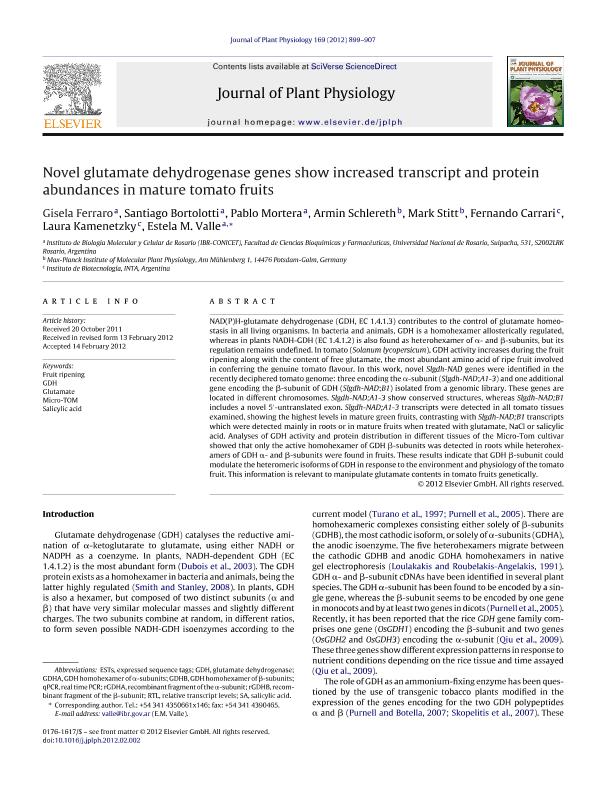Artículo
Novel glutamate dehydrogenase genes show increased transcript and protein abundances in mature tomato fruits
Ferraro, Gisela ; Bortolotti, Santiago; Mortera, Pablo
; Bortolotti, Santiago; Mortera, Pablo ; Schlereth, Armin; Stitt, Mark; Carrari, Fernando Oscar
; Schlereth, Armin; Stitt, Mark; Carrari, Fernando Oscar ; Kamenetzky, Laura
; Kamenetzky, Laura ; Valle, Estela Marta
; Valle, Estela Marta
 ; Bortolotti, Santiago; Mortera, Pablo
; Bortolotti, Santiago; Mortera, Pablo ; Schlereth, Armin; Stitt, Mark; Carrari, Fernando Oscar
; Schlereth, Armin; Stitt, Mark; Carrari, Fernando Oscar ; Kamenetzky, Laura
; Kamenetzky, Laura ; Valle, Estela Marta
; Valle, Estela Marta
Fecha de publicación:
06/2012
Editorial:
Elsevier Gmbh
Revista:
Journal of Plant Physiology
ISSN:
0176-1617
Idioma:
Inglés
Tipo de recurso:
Artículo publicado
Clasificación temática:
Resumen
NAD(P)H-glutamate dehydrogenase (GDH, EC 1.4.1.3) contributes to the control of glutamate homeostasis in all living organisms. In bacteria and animals, GDH is a homohexamer allosterically regulated, whereas in plants NADH-GDH (EC 1.4.1.2) is also found as heterohexamer of α- and β-subunits, but its regulation remains undefined. In tomato (Solanum lycopersicum), GDH activity increases during the fruit ripening along with the content of free glutamate, the most abundant amino acid of ripe fruit involved in conferring the genuine tomato flavour. In this work, novel Slgdh-NAD genes were identified in the recently deciphered tomato genome: three encoding the α-subunit (Slgdh-NAD; A1-3) and one additional gene encoding the β-subunit of GDH (Slgdh-NAD; B1) isolated from a genomic library. These genes are located in different chromosomes. Slgdh-NAD;A1-3 show conserved structures, whereas Slgdh-NAD;B1 includes a novel 5'-untranslated exon. Slgdh-NAD;A1-3 transcripts were detected in all tomato tissues examined, showing the highest levels in mature green fruits, contrasting with Slgdh-NAD;B1 transcripts which were detected mainly in roots or in mature fruits when treated with glutamate, NaCl or salicylic acid. Analyses of GDH activity and protein distribution in different tissues of the Micro-Tom cultivar showed that only the active homohexamer of GDH β-subunits was detected in roots while heterohexamers of GDH α- and β-subunits were found in fruits. These results indicate that GDH β-subunit could modulate the heteromeric isoforms of GDH in response to the environment and physiology of the tomato fruit. This information is relevant to manipulate glutamate contents in tomato fruits genetically. © 2012 Elsevier GmbH.
Palabras clave:
Fruit Ripening
,
Gdh
,
Glutamate
,
Micro-Tom
,
Salicylic Acid
Archivos asociados
Licencia
Identificadores
Colecciones
Articulos(IBR)
Articulos de INST.DE BIOLOGIA MOLECULAR Y CELULAR DE ROSARIO
Articulos de INST.DE BIOLOGIA MOLECULAR Y CELULAR DE ROSARIO
Articulos(IMPAM)
Articulos de INSTITUTO DE INVESTIGACIONES EN MICROBIOLOGIA Y PARASITOLOGIA MEDICA
Articulos de INSTITUTO DE INVESTIGACIONES EN MICROBIOLOGIA Y PARASITOLOGIA MEDICA
Articulos(IQUIR)
Articulos de INST.DE QUIMICA ROSARIO
Articulos de INST.DE QUIMICA ROSARIO
Articulos(SEDE CENTRAL)
Articulos de SEDE CENTRAL
Articulos de SEDE CENTRAL
Citación
Ferraro, Gisela; Bortolotti, Santiago; Mortera, Pablo; Schlereth, Armin; Stitt, Mark; et al.; Novel glutamate dehydrogenase genes show increased transcript and protein abundances in mature tomato fruits; Elsevier Gmbh; Journal of Plant Physiology; 169; 9; 6-2012; 899-907
Compartir
Altmétricas



